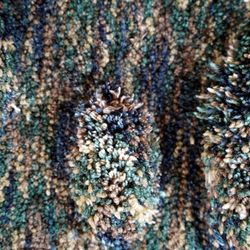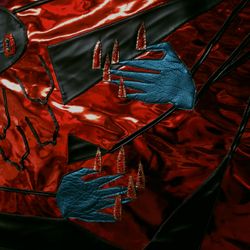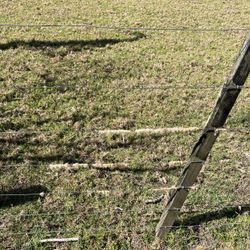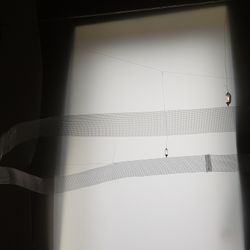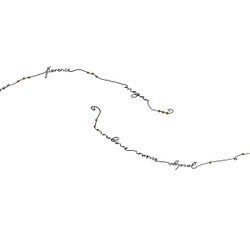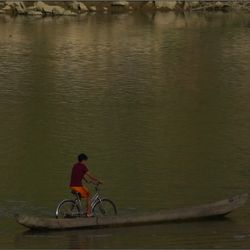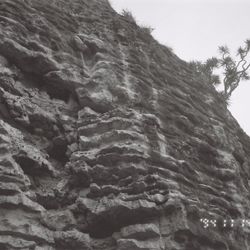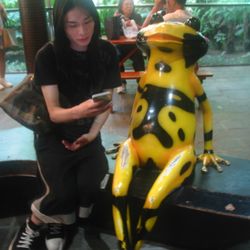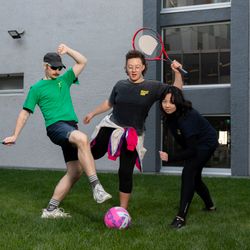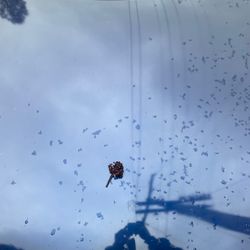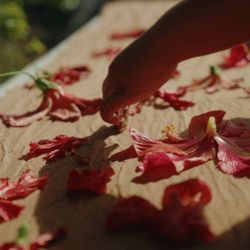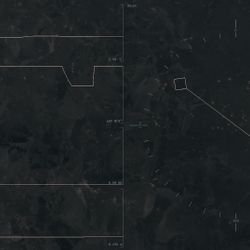Ngā raraunga o te Mākū: te hā o Haupapa, the data of moisture, the breath of Haupapa, is a new iteration in a series of artworks that emanate from Haupapa Tasman glacier. Haupapa is a body of ice formed from a deep exhalation of Aoraki, the ancestor mauka, as he readied to speak. The glacier is transforming into Aotearoa’s fastest-growing body of wai in the lake below releasing the ancient breath of those who walked there long ago.
Past Exhibition
Paraire 15 Hepetema -
Hātarei 28 Oketopa
Friday 15 September -
Saturday 28 October
2023
Live weather data recorded by NIWA Taihoro Nukurangi instruments near the Haupapa glacier are streamed continuously to form a site-responsive installation based on physical data of local weather conditions. The digital measurements spur Ron Bull’s voicings of names of elemental ancestors, recorded live on the lake, to gift and acknowledge Kāi Tahu names and mātauraka. The software also selects from a set of underwater images of glacial fragments and live hydrophone and atmospheric sound recordings. The ordering and qualities of sound and video are decided by the weather conditions of Aoraki. On days of high solar radiation, bright, clear ice and sun predominate and move the images on screen accordingly; on cloudy days, the image darkens. For the artwork’s iteration at Blue Oyster, the fluctuations of the data set are visible in the second room of the gallery.
Glaciologist Heather Purdie guided us at Haupapa. She has found that the glacier is melting from within crevasses in the glacier accumulation area that retain the sun’s heat; that at the end of Haupapa, there are submerged ice ramps in the lake, which cause large icebergs to split off and accelerate the glacier’s recession. Bull also guided and fuelled the project with an ethos of gifting and offering as we respond to the transforming elements.
Collaborating artists: Ron Bull (voice); Stefan Marks (programming); Janine Randerson (video); Rachel Shearer (sound); Heather Purdie (glaciologist and scientific advisor).
Acknowledgements:
Creative New Zealand Toi Aotearoa; NIWA Taihoro Nukurangi; Auckland University of Technology; Te Tuhi and the World Weather Network; Hocken Collections Uare Taoka o Hākena.
Ron Bull, Stefan Marks, Janine Randerson, Rachel Shearer, Heather Purdie, Ngā raraunga o te Mākū: te hā o Haupapa, 2023. Two-channel video, four-channel audio, custom software, live data feed courtesy of NIWA Taihoro Nukurangi, paper, recycled aluminium
Photo: Rosa Nevison
Ron Bull, Stefan Marks, Janine Randerson, Rachel Shearer, Heather Purdie, Ngā raraunga o te Mākū: te hā o Haupapa, 2023. Two-channel video, four-channel audio, custom software, live data feed courtesy of NIWA Taihoro Nukurangi, paper, recycled aluminium
Photo: Rosa Nevison
Ron Bull, Stefan Marks, Janine Randerson, Rachel Shearer, Heather Purdie, Ngā raraunga o te Mākū: te hā o Haupapa, 2023. Two-channel video, four-channel audio, custom software, live data feed courtesy of NIWA Taihoro Nukurangi, paper, recycled aluminium
Photo: Rosa Nevison
Ron Bull, Stefan Marks, Janine Randerson, Rachel Shearer, Heather Purdie, Ngā raraunga o te Mākū: te hā o Haupapa, 2023. Two-channel video, four-channel audio, custom software, live data feed courtesy of NIWA Taihoro Nukurangi, paper, recycled aluminium
Photo: Rosa Nevison
Ron Bull, Stefan Marks, Janine Randerson, Rachel Shearer, Heather Purdie, Ngā raraunga o te Mākū: te hā o Haupapa, 2023. Two-channel video, four-channel audio, custom software, live data feed courtesy of NIWA Taihoro Nukurangi, paper, recycled aluminium
Photo: Rosa Nevison
Ron Bull, Stefan Marks, Janine Randerson, Rachel Shearer, Heather Purdie, Ngā raraunga o te Mākū: te hā o Haupapa, 2023. Two-channel video, four-channel audio, custom software, live data feed courtesy of NIWA Taihoro Nukurangi, paper, recycled aluminium
Photo: Rosa Nevison
Ron Bull, Stefan Marks, Janine Randerson, Rachel Shearer, Heather Purdie, Ngā raraunga o te Mākū: te hā o Haupapa, 2023. Two-channel video, four-channel audio, custom software, live data feed courtesy of NIWA Taihoro Nukurangi, paper, recycled aluminium
Photo: Rosa Nevison
Ron Bull, Stefan Marks, Janine Randerson, Rachel Shearer, Heather Purdie, Ngā raraunga o te Mākū: te hā o Haupapa, 2023. Two-channel video, four-channel audio, custom software, live data feed courtesy of NIWA Taihoro Nukurangi, paper, recycled aluminium
Photo: Rosa Nevison
Ron Bull, Stefan Marks, Janine Randerson, Rachel Shearer, Heather Purdie, Ngā raraunga o te Mākū: te hā o Haupapa, 2023. Two-channel video, four-channel audio, custom software, live data feed courtesy of NIWA Taihoro Nukurangi, paper, recycled aluminium
Photo: Rosa Nevison
Ron Bull, Stefan Marks, Janine Randerson, Rachel Shearer, Heather Purdie, Ngā raraunga o te Mākū: te hā o Haupapa, 2023. Two-channel video, four-channel audio, custom software, live data feed courtesy of NIWA Taihoro Nukurangi, paper, recycled aluminium
Photo: Rosa Nevison
Ron Bull, Stefan Marks, Janine Randerson, Rachel Shearer, Heather Purdie, Ngā raraunga o te Mākū: te hā o Haupapa, 2023. Two-channel video, four-channel audio, custom software, live data feed courtesy of NIWA Taihoro Nukurangi, paper, recycled aluminium
Photo: Rosa Nevison
Ron Bull, Stefan Marks, Janine Randerson, Rachel Shearer, Heather Purdie, Ngā raraunga o te Mākū: te hā o Haupapa, 2023. Two-channel video, four-channel audio, custom software, live data feed courtesy of NIWA Taihoro Nukurangi, paper, recycled aluminium
Photo: Rosa Nevison
Ron Bull, Stefan Marks, Janine Randerson, Rachel Shearer, Heather Purdie, Ngā raraunga o te Mākū: te hā o Haupapa, 2023. Two-channel video, four-channel audio, custom software, live data feed courtesy of NIWA Taihoro Nukurangi, paper, recycled aluminium
Photo: Rosa Nevison
Ron Bull, Stefan Marks, Janine Randerson, Rachel Shearer, Heather Purdie, Ngā raraunga o te Mākū: te hā o Haupapa, 2023. Two-channel video, four-channel audio, custom software, live data feed courtesy of NIWA Taihoro Nukurangi, paper, recycled aluminium
Photo: Rosa Nevison
Ron Bull, Stefan Marks, Janine Randerson, Rachel Shearer, Heather Purdie, Ngā raraunga o te Mākū: te hā o Haupapa, 2023. Two-channel video, four-channel audio, custom software, live data feed courtesy of NIWA Taihoro Nukurangi, paper, recycled aluminium
Photo: Rosa Nevison
Ron Bull, Stefan Marks, Janine Randerson, Rachel Shearer, Heather Purdie, Ngā raraunga o te Mākū: te hā o Haupapa, 2023. Two-channel video, four-channel audio, custom software, live data feed courtesy of NIWA Taihoro Nukurangi, paper, recycled aluminium
Photo: Rosa Nevison
Ron Bull, Stefan Marks, Janine Randerson, Rachel Shearer, Heather Purdie, Ngā raraunga o te Mākū: te hā o Haupapa, 2023. Two-channel video, four-channel audio, custom software, live data feed courtesy of NIWA Taihoro Nukurangi, paper, recycled aluminium
Photo: Rosa Nevison
Ron Bull, Stefan Marks, Janine Randerson, Rachel Shearer, Heather Purdie, Ngā raraunga o te Mākū: te hā o Haupapa, 2023. Two-channel video, four-channel audio, custom software, live data feed courtesy of NIWA Taihoro Nukurangi, paper, recycled aluminium
Photo: Rosa Nevison
Ron Bull, Stefan Marks, Janine Randerson, Rachel Shearer, Heather Purdie, Ngā raraunga o te Mākū: te hā o Haupapa, 2023. Two-channel video, four-channel audio, custom software, live data feed courtesy of NIWA Taihoro Nukurangi, paper, recycled aluminium
Photo: Rosa Nevison
Ron Bull, Stefan Marks, Janine Randerson, Rachel Shearer, Heather Purdie, Ngā raraunga o te Mākū: te hā o Haupapa, 2023. Two-channel video, four-channel audio, custom software, live data feed courtesy of NIWA Taihoro Nukurangi, paper, recycled aluminium
Photo: Rosa Nevison
Ron Bull, Stefan Marks, Janine Randerson, Rachel Shearer, Heather Purdie, Ngā raraunga o te Mākū: te hā o Haupapa, 2023. Two-channel video, four-channel audio, custom software, live data feed courtesy of NIWA Taihoro Nukurangi, paper, recycled aluminium
Photo: Rosa Nevison
Ron Bull, Stefan Marks, Janine Randerson, Rachel Shearer, Heather Purdie, Ngā raraunga o te Mākū: te hā o Haupapa, 2023. Two-channel video, four-channel audio, custom software, live data feed courtesy of NIWA Taihoro Nukurangi, paper, recycled aluminium
Photo: Rosa Nevison
Ron Bull, Stefan Marks, Janine Randerson, Rachel Shearer, Heather Purdie, Ngā raraunga o te Mākū: te hā o Haupapa, 2023. Two-channel video, four-channel audio, custom software, live data feed courtesy of NIWA Taihoro Nukurangi, paper, recycled aluminium
Photo: Rosa Nevison
Ron Bull, Stefan Marks, Janine Randerson, Rachel Shearer, Heather Purdie, Ngā raraunga o te Mākū: te hā o Haupapa, 2023. Two-channel video, four-channel audio, custom software, live data feed courtesy of NIWA Taihoro Nukurangi, paper, recycled aluminium
Photo: Rosa Nevison
Ron Bull, Stefan Marks, Janine Randerson, Rachel Shearer, Heather Purdie, Ngā raraunga o te Mākū: te hā o Haupapa, 2023. Two-channel video, four-channel audio, custom software, live data feed courtesy of NIWA Taihoro Nukurangi, paper, recycled aluminium
Photo: Rosa Nevison
Ron Bull, Stefan Marks, Janine Randerson, Rachel Shearer, Heather Purdie, Ngā raraunga o te Mākū: te hā o Haupapa, 2023. Two-channel video, four-channel audio, custom software, live data feed courtesy of NIWA Taihoro Nukurangi, paper, recycled aluminium
Photo: Rosa Nevison
Ron Bull, Stefan Marks, Janine Randerson, Rachel Shearer, Heather Purdie, Ngā raraunga o te Mākū: te hā o Haupapa, 2023. Two-channel video, four-channel audio, custom software, live data feed courtesy of NIWA Taihoro Nukurangi, paper, recycled aluminium
Photo: Rosa Nevison
Ron Bull, Stefan Marks, Janine Randerson, Rachel Shearer, Heather Purdie, Ngā raraunga o te Mākū: te hā o Haupapa, 2023. Two-channel video, four-channel audio, custom software, live data feed courtesy of NIWA Taihoro Nukurangi, paper, recycled aluminium
Photo: Rosa Nevison
Ron Bull, Stefan Marks, Janine Randerson, Rachel Shearer, Heather Purdie, Ngā raraunga o te Mākū: te hā o Haupapa, 2023. Two-channel video, four-channel audio, custom software, live data feed courtesy of NIWA Taihoro Nukurangi, paper, recycled aluminium
Photo: Rosa Nevison
Ron Bull, Stefan Marks, Janine Randerson, Rachel Shearer, Heather Purdie, Ngā raraunga o te Mākū: te hā o Haupapa, 2023. Two-channel video, four-channel audio, custom software, live data feed courtesy of NIWA Taihoro Nukurangi, paper, recycled aluminium
Photo: Rosa Nevison
Ron Bull, Stefan Marks, Janine Randerson, Rachel Shearer, Heather Purdie, Ngā raraunga o te Mākū: te hā o Haupapa, 2023. Two-channel video, four-channel audio, custom software, live data feed courtesy of NIWA Taihoro Nukurangi, paper, recycled aluminium
Photo: Rosa Nevison
Ron Bull, Stefan Marks, Janine Randerson, Rachel Shearer, Heather Purdie, Ngā raraunga o te Mākū: te hā o Haupapa, 2023. Two-channel video, four-channel audio, custom software, live data feed courtesy of NIWA Taihoro Nukurangi, paper, recycled aluminium
Photo: Rosa Nevison
Ron Bull, Stefan Marks, Janine Randerson, Rachel Shearer, Heather Purdie, Ngā raraunga o te Mākū: te hā o Haupapa (installation view, timelapse video 1:48), 2023. Two-channel video, four-channel audio, custom software, live data feed courtesy of NIWA Taihoro Nukurangi, paper, recycled aluminium
Ron Bull is a Kāi Tahu mātauraka knowledge-holder and linguist. He is part of the Kaihaukai Collective and together with Simon Kaan has produced social exchanges based around food nationally and internationally, including at the International Symposium of Electronic Arts and the Museum of New Zealand Te Papa Tongarewa. He has also worked on collaborative art projects with artists such as Alex Monteith. Bull is a researcher on cross-cultural collaboration and engages with place-based narratives through social art practice.
Stefan Marks is a creative technologist in the School of Future Environments at Auckland University of Technology. His main areas of research are collaborative extended reality (XR) and data visualisation or, as he prefers to call it, ‘data-driven, immersive storytelling.’ Stefan creates tools to turn complex or abstract information into visual, audible and other sensory forms to allow the human brain to perceive, discover and understand patterns and relations. Some of his projects have dealt with earthquake data, the human nasal cavity anatomy and artificial neural network connectivity.
Janine Randerson is an artmaker of video installations, 16mm films, sound and online artworks. She often practises in collaboration with environmental scientists and community groups. Janine’s book Weather as Medium: Toward a Meteorological Art (MIT Press, 2018) focuses on modern and contemporary artworks that engage with our present and future weathers. She also generates art exhibitions, events and screening programmes.
Rachel Shearer investigates sound as a medium through a range of practices: public urban/site-specific and gallery-based installations; studio-based composing of experimental sound experiences/music; collaborating as a sound designer or composer for moving image and live performance events; and writing. A focus in Shearer’s work is thinking through Māori and Western philosophies and technologies around the materiality of sound and how we listen to the whenua.
Heather Purdie is a glaciologist at the University of Canterbury, with research expertise in glacier mass balance, dynamics and climate change, focusing on the mountain glaciers in Kā Tiritiri-o-te-moana, the Southern Alps of Aotearoa. She is interested in glaciological change that occurs over short temporal scales. Most recently, she has been exploring rapid change at lake-calving glaciers and the impact that crevasses have on glacier mass balance. She makes regular monitoring trips to Haupapa glacier and Lake Haupapa with a team of researchers.
